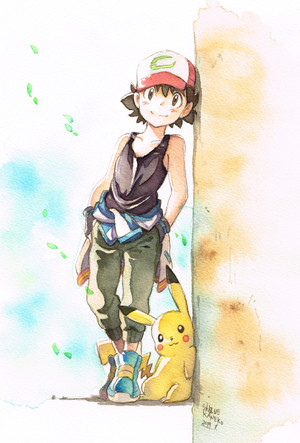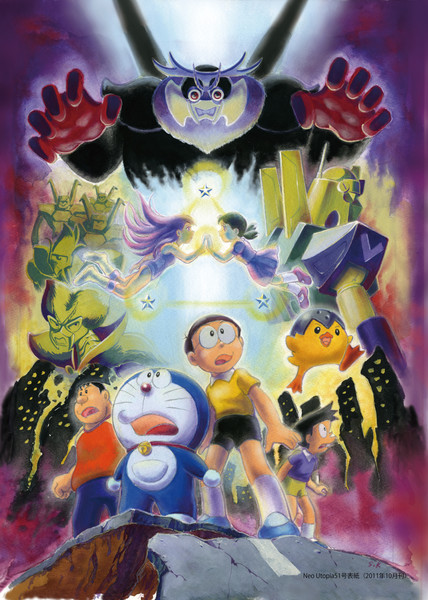Interview: Pokémon the Movie: The Power of Us Character Designer Shizue Kaneko
by Kim Morrissy & Callum May, It'd be difficult to overstate the importance of a great character designer on any anime. Not only are they responsible for creating the aesthetic and style of the characters themselves, but it's also their job to ensure that the designs can be effectively animated. To learn more about the process and ideas that go into creating characters, we reached out to Shizue Kaneko.
It'd be difficult to overstate the importance of a great character designer on any anime. Not only are they responsible for creating the aesthetic and style of the characters themselves, but it's also their job to ensure that the designs can be effectively animated. To learn more about the process and ideas that go into creating characters, we reached out to Shizue Kaneko.
Shizue Kaneko has worked in the anime industry as both a key animator and character designer, starting out at Shin-Ei Production. Since then, she has designed characters for Doraemon: Nobita and the New Steel Troops - Angel Wings, Monster Strike: The Movie, How NOT to Summon a Demon Lord, and most recently, Pokémon the Movie: The Power of Us.
What made you want to become an animator?
I've liked drawing pictures ever since I was a child. There weren't many toys in my house, so I would often draw pictures on the back of newspaper advertisements. I didn't go to school much, but I would just draw pictures (albeit scribbles). I was told that my family couldn't pay the fees, so I could only go once every few months, but my art teacher in high school taught me how to use tools for drawing pictures and sketches, and I would study while aiming to pass the entrance exam for art school. Because it costs money to take an entrance exam, I failed to get into the one university that I applied for, but it was a good experience because it was my first time having something to strive for.
After I graduated from high school, I looked around and studied advertisement design at a free class at a professional development school. I was juggling a part-time job while doing this, and as I was looking at job magazine thinking that I needed to find employment soon, I saw a recruitment call for animators. They didn't ask about experience so I applied, at which point I was told that if I wouldn't be hired if I didn't have experience or hadn't gone to a school and couldn't immediately go to work. So I saved up some money and went to a school with cheap fees and a short enrollment period.
From there, I got a job at Shinei Animation, the company that is the successor to A Production. I didn't want to become an animator so much as get a job drawing pictures that would earn me money. After I joined the company I wondered about what I wanted to do. Honestly, my hope was to become a director.
Is there a particular artist or anime that you believe influenced your work?
When I was a student, I often read the manga of Katsuhiro Ōtomo, which my brother owned. I also got introduced to Osamu Tezuka's manga through Buddha and various other works, which I read through the school library and the assembly hall. After I joined Shinei Animation, I got influenced by Tsutomu Shibayama and Eiichi Nakamura, who are the director and animation director of Doraemon respectively. But I think that the good and bad things I saw in everyday life outside of anime have had a greater influence on my art.

What things did you have to learn when you started doing character design?
After I learned how to in-between and draw key animation (although whether it was really learning in the true sense is another story), I helped the chief animation director and character designer by drawing small objects, guest characters, and throwaway characters for crowd shots, and so on. At that time, the character designer and chief animation director had a lot to do. There were less people in the system, so it was easy learn how to do the job by meeting with the more experienced hands and watching them.
Rather than becoming a character designer suddenly, I learned in order how to do in-betweens, key animation, animation directing and so on. As I rose in level, I naturally learned how to take on those jobs. By being versatile and gaining experience in a variety of areas, I could connect with the staff better in order to to deal with their difficulties and pressures.
What sort of instructions do you usually receive when creating your designs?
First of all, I read about the story's setting, but the instructions differ depending on the director. Some of them have their own image in mind beforehand, others take on your feelings as the illustrator and let you draw what you like, while others want your style to gel with theirs, and others still use your ideas as a springboard for other ideas. But thankfully in my case, my designs have suited many of the directors I've worked with. However, it doesn't happen often, but depending on who's giving the instructions, I feel like a mercenary who only works for money.
Who was your favourite character to design?
Although I wasn't the one to give birth to the characters, I liked drawing the mecha designs for Amu and Imu from Doraemon: Nobita and the New Steel Troops—Winged Angels, the bug robot, the ladybug robot, and so on. I don't get the chance to draw mecha-like things very often, but I like it.
What sort of feelings did you want to deliver with your illustrations in the ending credits?
With Pokémon, the credits tell an after story, so I imagined things among those lines. Rather than what I wanted to see, I prioritized images that would easily convey a story to the audience. The audience is already fired up from the main feature, so I wanted to make an impression by using watercolors, which is a different art style. But I didn't take much time to draw those illustrations so there's a bit of regret in my heart.
What things do you need to pay attention to when designing for kids anime compared to late night anime?
The biggest differences are, say, how you express sexuality and violence. Late night anime tends to be aimed at older audiences, so the more revealing designs tend to be for late night anime, but what the audience naturally seeks and what is considered easy to convey will depend on the type of audience you're dealing with. However, as everyone may be aware, there are some things that transcend those ideas.

What do you think is important to focus on when creating a great character design?
That's a really hard thing to express in words. I suppose it's an artwork that feels as if it's living, even though it's just a picture on a page. The person who is looking at the artwork feels their imagination being sparked.
Also, you need to have a certain degree of design sense and experience to draw simple designs with concise and abbreviated lineart. Otherwise, you end up making the drawings too complex, which makes it hard to draw. Personally, I'm drawn to the things that have a sense of beautiful simplicity. As they say, work is life, and life is work. I like it when artists put their own lives into their designs.
How would you describe the style of your character designs?
It depends on the work, but with Pokémon I was aiming for simple and realistic designs, with characters wearing clothes a real person might actually wear. Also, the director told me to draw things with my usual touch, and I normally draw things with a soft and gentle atmosphere. If only I had more time, I would have stuck at it a little more, but that's for my satisfaction.
With other projects, I have to match the overall style and do what I can to decrease the burden on everyone working on it. When I draw, I think about how many colors to use and what aspects of the drawing need the most detail. I add and decrease the number of lines for the important parts to make them easier to animate.

How do you decide on what colors will be used in your designs?
There's a department called “color setting”, where you plan what colors to use. The colors I use are generally based upon the color setting designer's creation. Usually, the director, color setting designer, and the character designer have meetings together to decide on a design. At the meetings, the character designers convey how they imagine each part to be like that, and after everyone consults each other about it, they make a decision.
What surprising thing can you tell us about your design work?
There's nothing that's really too surprising, but sometimes I can see a clear image in my mind. Also, when I'm attempting a new genre, I sometimes have to discover new things about myself in order to come up with a new design. The good and bad things that I discover about myself surprise me at times.
What is the one big thing that you want anime fans to understand about character design or animation in anime?
We just make things based on what we're thinking. Yes, there are times when we are happy when our intentions get across, but the work is something for other people to take in and understand for themselves. I'm happy if your life experience as the audience makes the work deeper, and if you made it into something you can personally enjoy. That's why I think that if you can live in a way that things move you and stretch your imagination, you'll be able to enjoy our work even more. If you hone your imagination, it makes you better at empathizing and being kind to others, and it'll also deepen your appreciation of the things we make. The people around you will appreciate that about you. It's killing two birds with one stone. (laughs)
You work at a variety of different studios. What would you say is unique about working at OLM?
I do my design work at home and hardly ever come into the studio, but the studio is a place where you can make animation in a paperless environment. When we were deciding on the Pokémon designs, we really didn't have much time, but we often had our meetings at a cafe in Shinjuku. As we all ate giant parfaits, the director and I would draw designs with pencils and keep revising them. It was a very busy and difficult time, but I won't forget how much fun I had.

Is there anything you'd like to say to overseas fans?
Pictures and films unite people regardless of race and ethnicity. Everyone has things that cause them stress and worry in their lives. Our job is to help others in those moments, so please use our work to make you smile, fill you with ease, or provoke thought sometimes. Thank you for watching!
Thanks to Shizue Kaneko for kindly providing the illustrations shown in this interview.
discuss this in the forum (14 posts) |